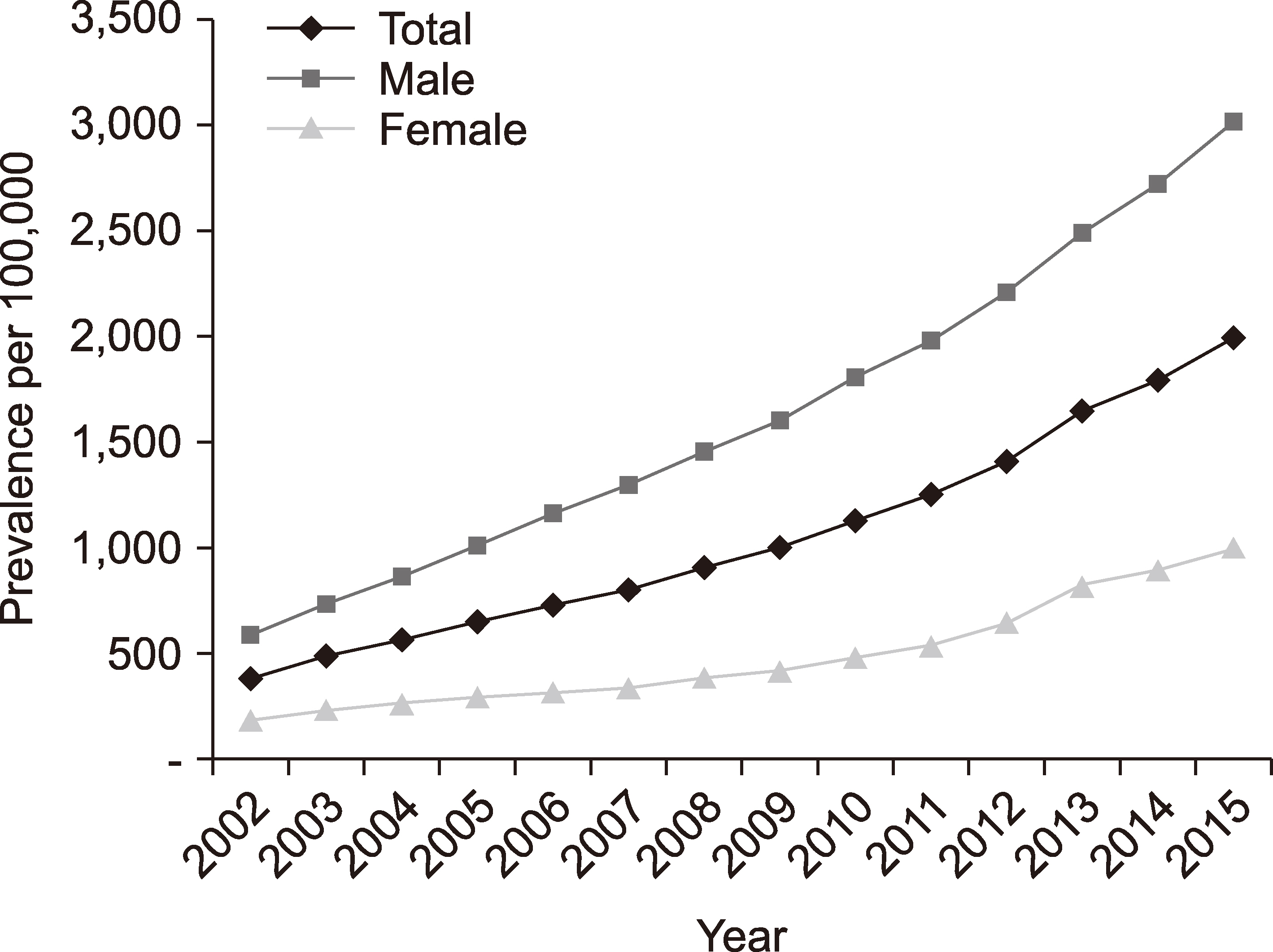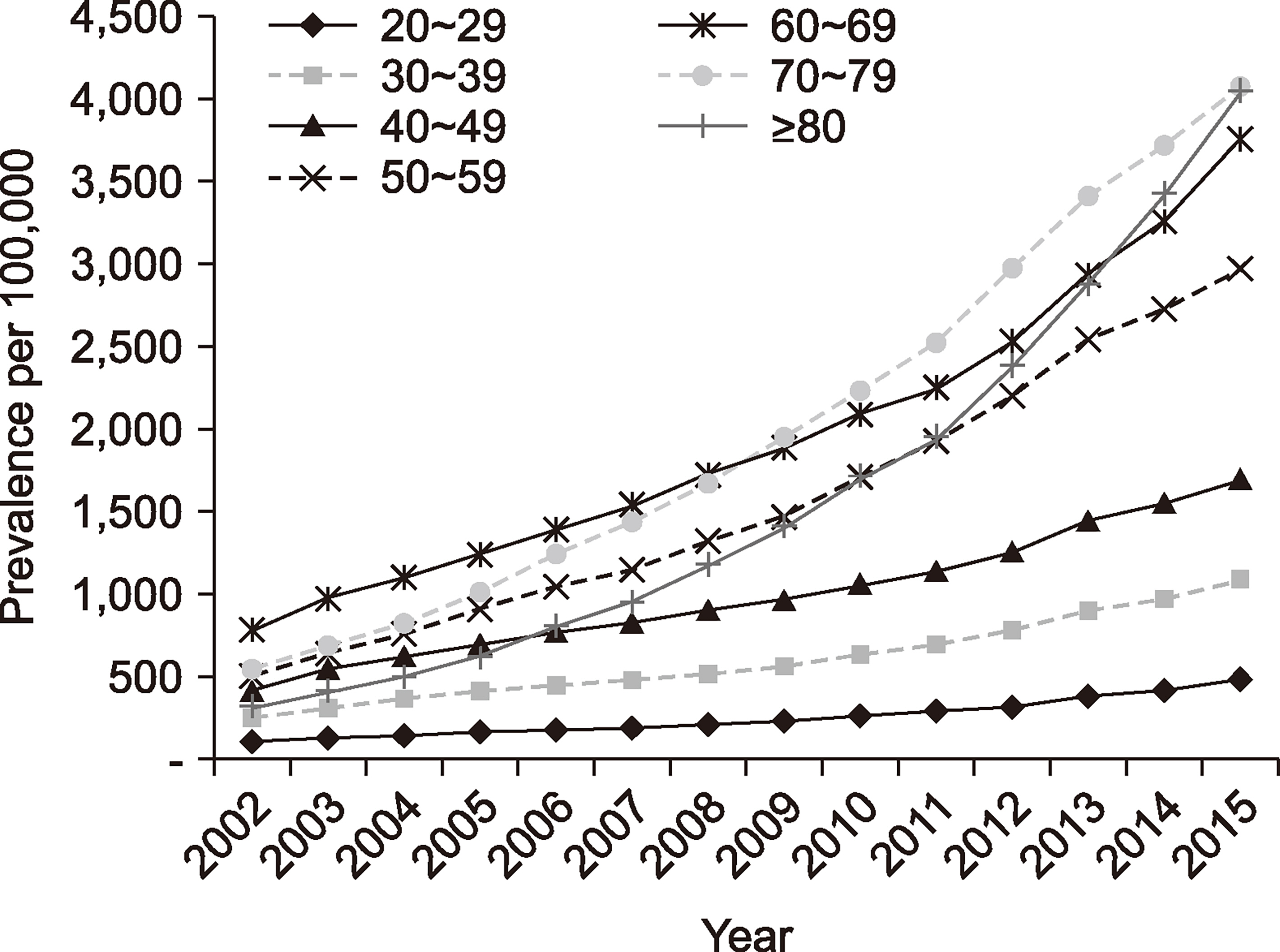J Rheum Dis.
2020 Jul;27(3):174-181. 10.4078/jrd.2020.27.3.174.
Trends of Gout Prevalence in South Korea Based on Medical Utilization: A National Health Insurance Service Database (2002∼2015)
- Affiliations
-
- 1Division of Rheumatology, Department of Internal Medicine, Korea
- 2Research and Analysis Team, National Health Insurance Service Ilsan Hospital, Goyang, Korea
- 3Division of Rheumatology, Department of Internal Medicine, Chung-Ang University College of Medicine, Seoul, Korea
- KMID: 2504033
- DOI: http://doi.org/10.4078/jrd.2020.27.3.174
Abstract
Objective
. Although gout is the most common form of inflammatory arthritis, data on gout prevalence and management are sparse, especially in Korean populations. This study reevaluated the most recent prevalence and incidence of gout values in Korean people to update the findings from our previous study in 2011.
Methods
. We used the National Health Insurance Service-National Health Information Database (NHIS-NHID) to identify patients diagnosed with gout in South Korea during 2002∼2015. We selected patients with gout as principal diagnosis or 1st∼4th additional diagnosis.
Results
. The prevalence of gout increased 5.17-fold, from 0.39% in 2002 to 2.01% in 2015. This increase occurred in all age groups, but was stronger in those aged 80 years or older, with a 13.1-fold increase from 2002 to 2015. The prevalence of gout increased in all regions of South Korea. The prevalence of the disease was also related to income levels: in 2015, medical insurance subscribers with the highest income were twice more likely to have gout than those in the lowest income bracket. By contrast, the prevalence of gout in medical benefit recipients was 5.58- and 5.25-times higher than that of the general population and of those in the highest income bracket, respectively.
Conclusion
. The prevalence of gout has increased rapidly, although the degree of increase varied according to sex, age, region, and income group. This study sheds some light on the current prevalence of gout among national insurance subscribers in Korea, and will help educate patients and medical staff on the management of gout.
Keyword
Figure
Cited by 2 articles
-
Clinical Study Using Healthcare Claims Database
Jin-Su Park, Chan Hee Lee
J Rheum Dis. 2021;28(3):119-125. doi: 10.4078/jrd.2021.28.3.119.Patient Perspectives and Preferences Regarding Gout and Gout Management: Impact on Adherence
Min Kyung Chung, Sung Soo Kim, Yun-Hong Cheon, Seung-Jae Hong, Hyo Jin Choi, Mi Ryoung Seo, Jiwon Hwang, Joong Kyong Ahn, Sang-Heon Lee, Hong Ki Min, Hoon-Suk Cha, Shin-Seok Lee, Jennifer Lee, Ki Won Moon, Chang-Keun Lee, Hyun-Ok Kim, Young Sun Suh, Seung-Cheol Shim, Seong Wook Kang, Jinhyun Kim, Sang Tae Choi, Jung Soo Song, Jisoo Lee,
J Korean Med Sci. 2021;36(32):e208. doi: 10.3346/jkms.2021.36.e208.
Reference
-
1. Richette P, Bardin T. 2010; Gout. Lancet. 375:318–28. DOI: 10.1016/S0140-6736(09)60883-7. PMID: 26136557. PMCID: PMC4572392.
Article2. Lee SJ, Hirsch JD, Terkeltaub R, Khanna D, Singh JA, Sarkin A, et al. 2009; Perceptions of disease and health-related quality of life among patients with gout. Rheumatology (Oxford). 48:582–6. DOI: 10.1093/rheumatology/kep047. PMID: 19307257. PMCID: PMC2722803.
Article3. Lee CH, Sung NY. 2011; The prevalence and features of Korean gout patients using the National Health Insurance Corporation database. J Rheum Dis. 18:94–100. DOI: 10.4078/jrd.2011.18.2.94.
Article4. Anagnostopoulos I, Zinzaras E, Alexiou I, Papathanasiou AA, Davas E, Koutroumpas A, et al. 2010; The prevalence of rheumatic diseases in central Greece: a population survey. BMC Musculoskelet Disord. 11:98. DOI: 10.1186/1471-2474-11-98. PMID: 20504294. PMCID: PMC2890601.
Article5. Bardin T, Bouée S, Clerson P, Chalès G, Flipo RM, Lioté F, et al. 2016; Prevalence of gout in the adult population of France. Arthritis Care Res (Hoboken). 68:261–6. DOI: 10.1002/acr.22660. PMID: 26234279.
Article6. Kuo CF, Grainge MJ, Mallen C, Zhang W, Doherty M. 2015; Rising burden of gout in the UK but continuing suboptimal management: a nationwide population study. Ann Rheum Dis. 74:661–7. DOI: 10.1136/annrheumdis-2013-204463. PMID: 24431399. PMCID: PMC4392307.
Article7. Sicras-Mainar A, Navarro-Artieda R, Ibáñez-Nolla J. 2013; Resource use and economic impact of patients with gout: a multicenter, population-wide study. Reumatol Clin. 9:94–100. DOI: 10.1016/j.reumae.2012.06.029. PMID: 23313534.
Article8. Kuo CF, Grainge MJ, Zhang W, Doherty M. 2015; Global epidemiology of gout: prevalence, incidence and risk factors. Nat Rev Rheumatol. 11:649–62. DOI: 10.1038/nrrheum.2015.91. PMID: 26150127.
Article9. Zhu Y, Pandya BJ, Choi HK. 2011; Prevalence of gout and hyperuricemia in the US general population: the National Health and Nutrition Examination Survey 2007-2008. Arthritis Rheum. 63:3136–41. DOI: 10.1002/art.30520. PMID: 21800283.
Article10. Miao Z, Li C, Chen Y, Zhao S, Wang Y, Wang Z, et al. 2008; Dietary and lifestyle changes associated with high prevalence of hyperuricemia and gout in the Shandong coastal cities of Eastern China. J Rheumatol. 35:1859–64.11. Kim EH, Jeon K, Park KW, Kim HJ, Ahn JK, Jeon CH, et al. 2004; The prevalence of gout among hyperuricemic population. J Korean Rheum Assoc. 11:7–13.12. Kim JW, Kwak SG, Lee H, Kim SK, Choe JY, Park SH. 2017; Prevalence and incidence of gout in Korea: data from the national health claims database 2007-2015. Rheumatol Int. 37:1499–506. DOI: 10.1007/s00296-017-3768-4. PMID: 28676911.
Article13. Mikuls TR, Farrar JT, Bilker WB, Fernandes S, Schumacher HR Jr, Saag KG. 2005; Gout epidemiology: results from the UK General Practice Research Database, 1990-1999. Ann Rheum Dis. 64:267–72. DOI: 10.1136/ard.2004.024091. PMID: 15647434. PMCID: PMC1755343.
Article14. Chuang SY, Lee SC, Hsieh YT, Pan WH. 2011; Trends in hyperuricemia and gout prevalence: Nutrition and Health Survey in Taiwan from 1993-1996 to 2005-2008. Asia Pac J Clin Nutr. 20:301–8. PMID: 21669599.15. Winnard D, Wright C, Taylor WJ, Jackson G, Te Karu L, Gow PJ, et al. 2012; National prevalence of gout derived from administrative health data in Aotearoa New Zealand. Rheumatology (Oxford). 51:901–9. DOI: 10.1093/rheumatology/ker361. PMID: 22253023.
Article16. Choi HJ, Lee CH, Lee JH, Yoon BY, Kim HA, Suh CH, et al. 2015; Seasonality of gout in Korea: a multicenter study. J Korean Med Sci. 30:240–4. DOI: 10.3346/jkms.2015.30.3.240. PMID: 25729244. PMCID: PMC4330476.
Article17. Kim Y, Kang J, Kim GT. 2018; Prevalence of hyperuricemia and its associated factors in the general Korean population: an analysis of a population-based nationally representative sample. Clin Rheumatol. 37:2529–38. DOI: 10.1007/s10067-018-4130-2. PMID: 29790110.
Article18. Wang W, Bhole VM, Krishnan E. 2015; Chronic kidney disease as a risk factor for incident gout among men and women: retrospective cohort study using data from the Framingham heart study. BMJ Open. 5:e006843. DOI: 10.1136/bmjopen-2014-006843. PMID: 25869687. PMCID: PMC4401834.
Article19. Jing J, Kielstein JT, Schultheiss UT, Sitter T, Titze SI, Schaeffner ES, et al. GCKD Study Investigators. 2015; Prevalence and correlates of gout in a large cohort of patients with chronic kidney disease: the German Chronic Kidney Disease (GCKD) study. Nephrol Dial Transplant. 30:613–21. DOI: 10.1093/ndt/gfu352. PMID: 25395390.20. Dehlin M, Drivelegka P, Sigurdardottir V, Svärd A, Jacobsson LT. 2016; Incidence and prevalence of gout in Western Sweden. Arthritis Res Ther. 18:164. DOI: 10.1186/s13075-016-1062-6. PMID: 27412614. PMCID: PMC4944470.
Article
- Full Text Links
- Actions
-
Cited
- CITED
-
- Close
- Share
- Similar articles
-
- The Prevalence and Features of Korean Gout Patients Using the National Health Insurance Corporation Database
- Trends in Electroconvulsive Therapy Utilization in South Korea: Health Insurance Review Data From 2008 to 2018
- Leveraging National Health Insurance Service Data for Public Health Research in Korea: Structure, Applications, and Future Directions
- Use of Pulmonary Rehabilitation for Lung Cancer Patients in Korea: Analysis of the National Health Insurance Service Database
- Prevalence and Current Status of Dental Treatment for Amelogenesis Imperfecta and Dentinogenesis Imperfecta using National Health Insurance Database



